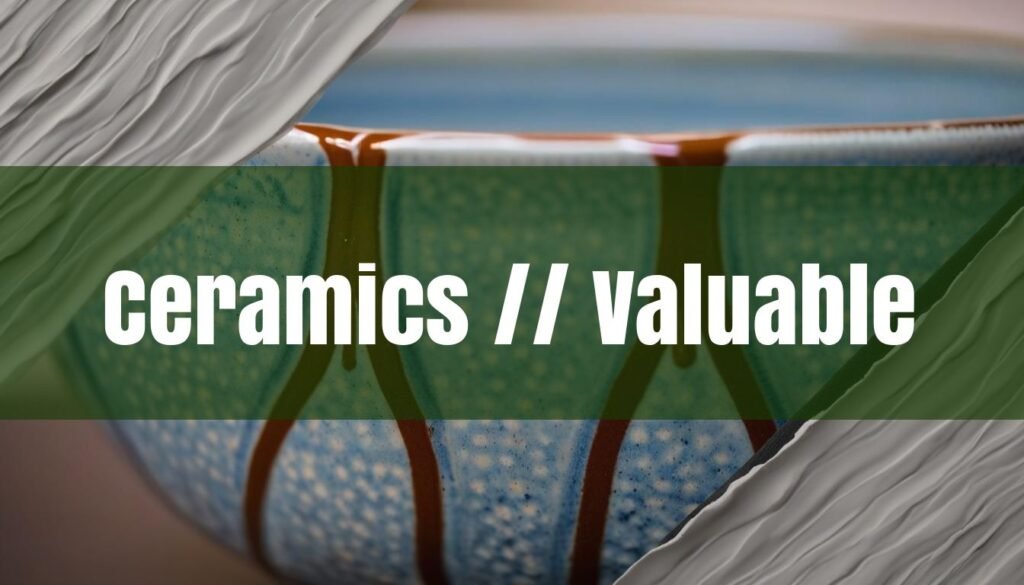The world of ceramics is vast and varied, offering a captivating journey through history, artistry, and culture. Determining which ceramics are valuable involves understanding a confluence of factors that go beyond mere aesthetics. Historical significance, rarity, the artist or manufacturer, condition, and provenance all play pivotal roles in establishing the worth of a ceramic piece. Collectors and enthusiasts alike are drawn to ceramics that tell a story, represent a unique period, or showcase exceptional craftsmanship.
Key Factors Determining Value
Several elements contribute to the value of ceramics. Historical significance is paramount; pieces that reflect important historical events, cultural movements, or technological advancements often command higher prices. Rarity is another critical factor, as items produced in limited quantities or those with few surviving examples are highly sought after. The artist or manufacturer significantly influences value; ceramics from renowned makers like Meissen, Sèvres, and Wedgwood are particularly prized. Condition is also crucial; ceramics in excellent or mint condition typically fetch the highest prices, although rare pieces may still be valuable despite some flaws. Lastly, provenance, or the documented history of ownership, can greatly enhance the value of an antique, especially if it was once owned by a famous figure or comes from an important estate. It is also important to check for a designer’s mark or signature, as a ceramic with this will always be worth more than one without it.
Highly Sought-After Ceramic Types
Certain types of ceramics consistently attract collectors due to their unique characteristics and historical importance. Antique porcelain from renowned European manufacturers like Meissen, Sèvres, and Wedgwood are highly coveted. Wedgwood, known for its iconic Jasperware and classical motifs, has been a favorite among collectors since its establishment in 1895. Sèvres porcelain, with its exquisite detail and association with the French royal court, also fetches high prices. Studio pottery from influential ceramic artists like Bernard Leach, considered the father of British studio pottery, elevates pottery to an art form, making their pieces highly valuable. Other notable types include Rookwood Pottery, an American company known for decorative art pottery, and Mochaware, recognized for its distinctive swirled patterns. Chinese ceramics, particularly those from the Ming Dynasty, are also highly valuable. Ming ceramics are easily recognized for their classic blue and white porcelain, and often feature a reign mark that indicates the dynasty during which the piece was made, rather than a maker’s mark. Also, Blackware is known for its rich black color and association with indigenous regions, including Southwest Native Americans and pre-Columbian tribes. You may also be interested in Native American Pottery. Also, don’t forget to explore the story of Chinese porcelain.
Identifying and Authenticating Valuable Ceramics
Identifying valuable ceramics requires a keen eye and a basic understanding of marks, signatures, and other identifying features. Maker’s marks, often found on the bottom of the piece, can provide crucial information about the origin and authenticity of the ceramic. Researching these marks in reputable identification guides can help determine the manufacturer and approximate age of the piece. Palettes and glazes can also offer clues about the period and style of the ceramic; for example, antique Asian ceramics from the Kangxi Dynasty are known for their shiny underglazes, while Mid-century modern pieces often feature more muted palettes. Assessing the condition of the ceramic is equally important. Look for signs of wear and tear, such as scratches, chips, cracks, and discoloration, but also be aware that some imperfections may be acceptable in rare pieces. Finally, consulting with experts and authenticating the ceramic through professional testing can provide additional assurance of its value and authenticity. Some modern ceramics are made in factories, and appear very uniform. Antique or vintage ceramics will often have an imperfect look from being handmade.
Antique or vintage ceramics will often have an imperfect look from being handmade.
Market Trends and Influences
The market for valuable ceramics is dynamic, influenced by changing tastes, economic conditions, and collecting trends. Auctions, galleries, and online platforms play a significant role in driving prices and shaping collecting preferences. Keeping abreast of current trends can help collectors make informed decisions about buying and selling ceramics. For instance, there has been a growing appreciation for studio pottery and contemporary ceramic art, with collectors drawn to innovative designs and techniques. Mid-century modern ceramics, characterized by bold colors and geometric shapes, have also gained popularity in recent years. Conversely, some traditional styles, like Majolica ware, have experienced fluctuations in popularity. Despite fluctuations in the market, the timeless beauty and historical significance of valuable ceramics continue to captivate collectors and enthusiasts worldwide. The key is to stay informed, appreciate the artistry and history behind each piece, and collect what brings joy and personal satisfaction.





